If you’ve been lucky enough to see a Cayuga duck up close, you’ve no doubt been mesmerized by their shimmering black-green plumage, blue-tinted wings, and delicate features. There’s more to this stunning bird than meets the eye, though, so get ready to discover all there is to know about the Cayuga duck.

Quick Facts about the Cayuga Duck
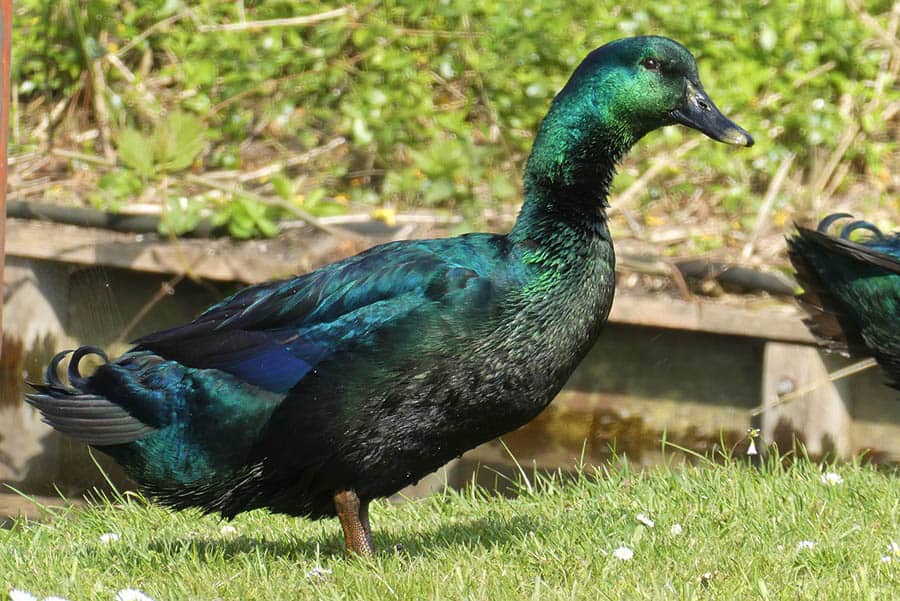
| Breed Name: | Cayuga |
| Place of Origin: | The United States |
| Uses: | Ornamental, eggs, meat, manure, pest control |
| Drake (Male) Size: | 6.5–8 lbs, 4–5 inches tall |
| Hen (Female) Size: | 6–7 lbs, 4–5 inches tall |
| Color: | Black, green, blue |
| Lifespan: | 8–12 years |
| Climate Tolerance: | Tolerates cold and moderate climates well |
| Care Level: | Low–moderate |
| Production: | Eggs, meat, manure |
Cayuga Duck Origins
The Cayuga first entered the history books in 1840. The duck’s exact origins are unclear—some believe that the Cayuga is related to an English black duck breed, whereas others believe they descended from wild ducks in the United States.
Whatever the case, it was in 1840 that Cayuga ducklings were taken to the finger Lakes Region in New York State by a man named John S. Clark. They were named after the Cayuga people of the Finger Lakes region and were commonly raised for meat.
When the American Pekin duck became the top meat duck in America, Cayugas were less commonly reared for their meat, and over the years, the Cayuga population dwindled. Today, the breed is considered “threatened” by the Livestock Conservancy.
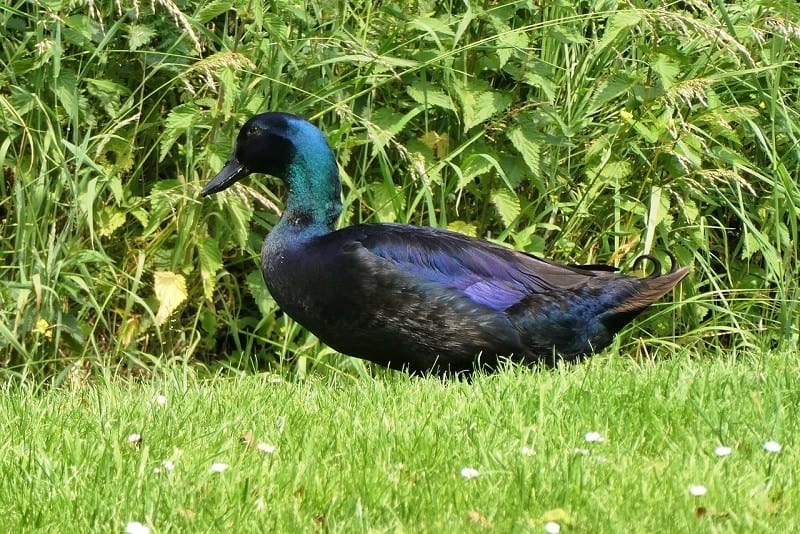

Cayuga Duck Characteristics
Cayugas are easy to spot because of their distinctive black, green, and blue plumage. They are medium in size but quite heavy, weighing approximately 6.5–8 lbs (drakes) and 6–7 lbs (hens). They have long necks and a somewhat stocky-looking body type. Due to their weight, Cayugas are poor flyers.
Hens lay approximately 100–150 eggs per year, and egg color changes depending on the season. Eggs laid at the start of the season appear to be black but are in fact more of a murky green color. In Autumn, the eggs become paler and can range from gray to gray-blue or green to completely white.
Temperament-wise, Cayugas are quiet, friendly, and docile if socialized well from a young age. This coupled with their poor flying abilities makes them less likely to attempt an escape, which in turn makes them a popular pet choice for enthusiasts. If taken good care of, Cayugas can live for up to 12 years.
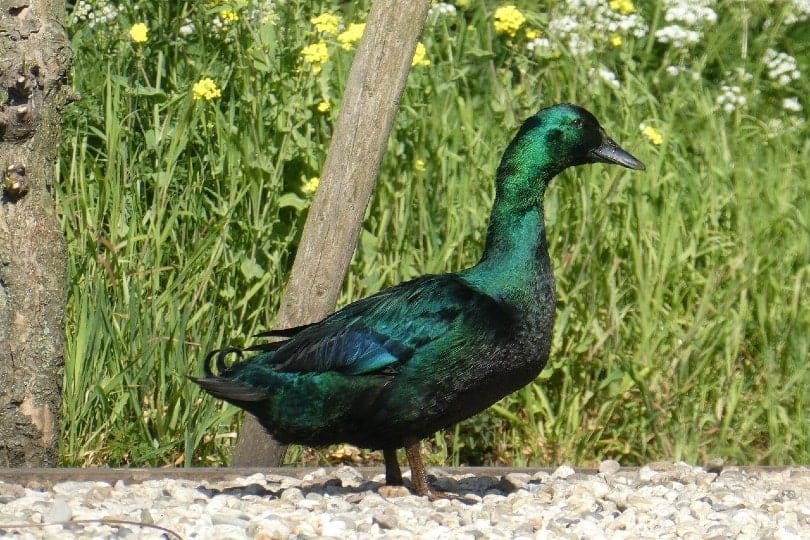
Uses
In the 19th century, Cayugas were the most popular meat duck in America until the American Pekin duck took over. Today, Cayugas are a threatened breed and are largely kept as pets or ornamental ducks by enthusiasts. They are occasionally raised for meat and eggs still, but this is far less common than in the past.
Appearance & Varieties
Cayugas are extremely distinctive thanks to their iridescent plumage—black tinted with startling green and blue-flecked wings. Out of the light, Cayugas appear completely black but in the sun, their colors give off a shimmering effect, making for a very eyecatching duck indeed. As they age, some or a large portion of their feathers turn white.
Cayuga ducklings are entirely black until they get a little older, and their feathers are very soft. The Cayuga’s beak is a mix of yellow and black, and the legs and feet are black.
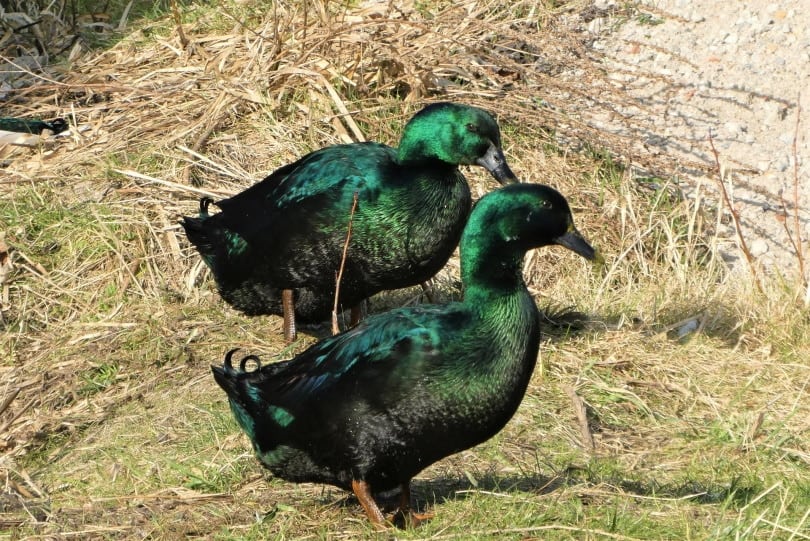
Population/Distribution/Habitat
In the 19th century, Cayugas were widely bred for their meat but today, they are a threatened species, with less than 1,000 remaining in the U.S. The Cayuga’s natural habitat is aquatic areas like ponds and lakes, though they are mostly kept as backyard pets today.
They have a reputation for being quite hardy, meaning they do well in cold winters. That said, they do still need a level of protection—shelter should be provided in winter, as should a shady area in hot weather. Though they’re not going to fly away, it may be worth securing their living space against predators—the gentle Cayuga isn’t the best at self-defense.
Cayuga ducks naturally enjoy being close to water and shrubbery for foraging, so a pond or pool would be ideal for backyard Cayugas. As carnivores, Cayuga ducks eat snails, slugs, and insects. They are excellent foragers so are pretty adept at finding their own food if they have enough space, but you can supplement their diet with commercial duck food.
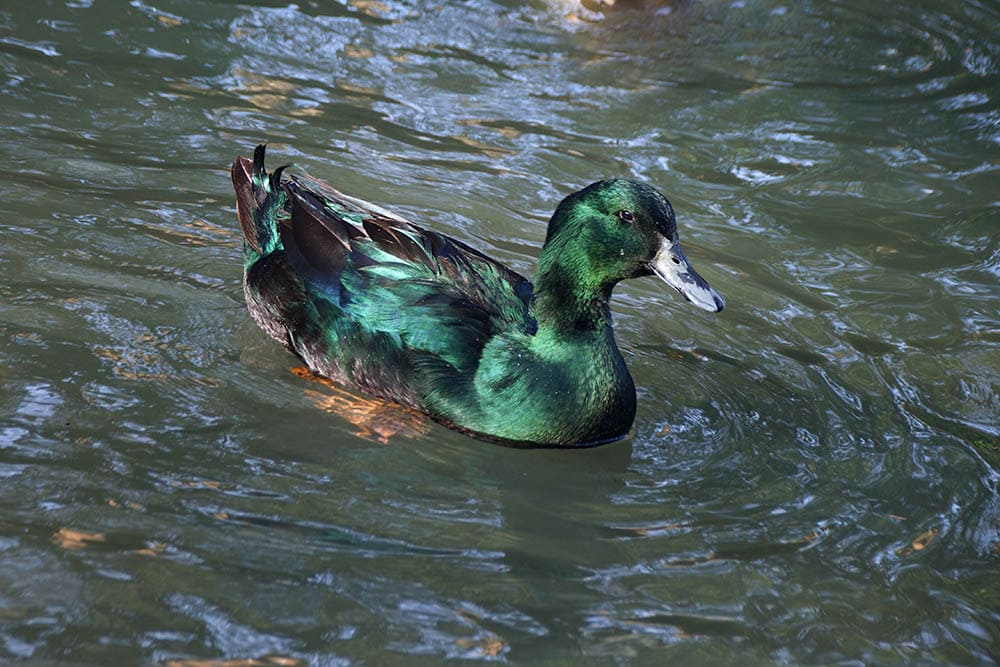

Are Cayuga Ducks Good for Small-Scale Farming?
Today, Cayugas are mostly kept as pets, and those who keep them do benefit greatly from keeping Cayugas around. Some people sell their eggs or keep them to eat at home, whereas others sell hatching eggs to other enthusiasts so they can raise their own Cayugas. Likewise, Cayugas are sometimes raised for meat, but it’s not very common.
Cayugas are highly beneficial for pest control on farms, ranches, and homesteads because of their foraging skills. Their manure is also great for the soil. People who raise Cayugas often enjoy their company—by all accounts, they’re beautiful, sweet, and pleasant backyard companions that don’t get themselves into too much trouble.
Featured Image Credit: Marina_Saw_it, Shutterstock
